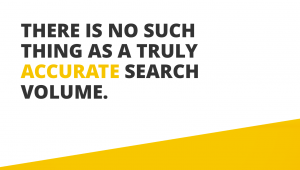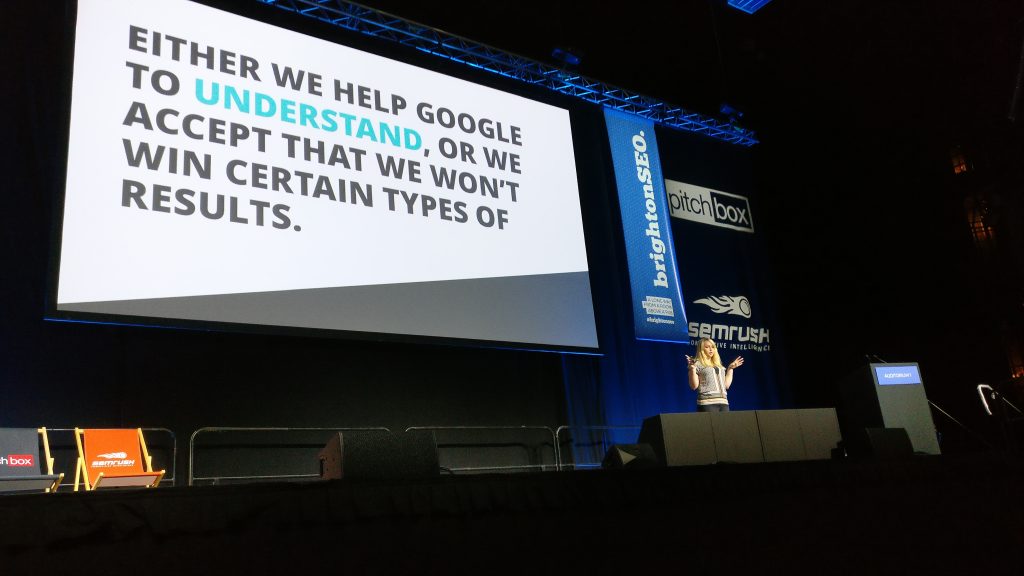At this year’s BrightonSEO, Hannah Thorpe – Head of SEO Strategy here at Found, spoke about ‘SEO without traffic’.
See the slideshow at the base of this post.
With an ever-changing digital landscape, there’s been a clear shift in how SEO is best implemented. Google’s shifting algorithm, the introduction of machine learning and focus on brand search mean that standard SEO practices need to adapt to the change.
It’s not simply a case of thinking outside the box, you need to steer clear of the more obvious SEO tactics and instead become more user-centric. In this talk, Hannah covers the most important aspects of SEO you need to consider when trying to convert high rankings into high traffic.
Think higher up the funnel
The first thing to remember is that you need to think higher up the funnel. When creating content for your brand, it’s about appealing to a broader audience group; especially at the awareness stage of the purchasing journey. It’s good to write content using terms with high search volumes, but how accurate are these measurements?

If you take a snapshot of search volumes in one area, there doesn’t seem to be much variation. Google Adwords has the same search volumes for a variety of similar terms, so while this is a good gauge of what people are searching for, in reality it’s a case of understanding the consumer’s journey and what part of the funnel they are at instead.
Rather than focusing on high search volumes terms, instead ask yourself; ‘What are your customers doing?’ and ‘what type of information do they need?’. Create content based on their intentions, not merely on the keyword volume says.

Simplify your content and using structured data
Start by simplifying your content – user attention span is getting smaller with every search, meaning that you need to produce concise, user-focused content.
All written content can follow a simple three-step process. First you need to introduce the main point of the content, next expand the point by providing examples, and then finally, give an opinion and analysis of these examples.
Your simplified content can also take other forms, including tables and lists. This type of structured data is a standardised format of providing information about a page and classifying page content. Content can be formatted in a more digestible manner by letting the search engine know how you want your content structured.
Tables are a good way of consolidating loads of information in a small, consumable format, while you can use numbers or bullet points to create lists. This type of structured content is more likely to appear in search results – perfect for high CTRs.
If there are products with images and prices, then this information should be structured so it can be displayed in the search engine results. Similarly, structuring small snippets of information in tables or lists will give clarity to articles.
But what about when there are zero search results? Even if there are low search volume and limited results for a search term, we want to help Google understand the type of content important to our users. So we either produce content and help Google understand what our audience is searching for, or we accept that we won’t win certain types of results.
Deserve to rank
There comes a point where you need to deserve to rank. In your vertical, there may be a wide range of brands delivering the same products at the same prices, so why would consumers choose you? You need to provide Google with evidence that you’re the preferred brand, otherwise, you’re at risk of being lost in a competitive sea of similar offerings.
The users searching for the products in your vertical need to think about your brand, talk about your brand, search for your brand and click on your brand. When the Google results page is such a competitive space, all brands need to stand out and be unique. This is not an easy task, but creating content with your brand in mind, as opposed to focusing on competitors, will give Google a reason to make your products more prominent in search.
Focus on users
If we created the perfect search engine, what would this mean or look like? We would say the perfect search engine would really understand whatever your need is. It would also understand everything in the world and return results for exactly what you need.
The clear focus here is ‘you’. You means ‘the user’, the one who is searching for a helpful, informative answer to any query they may have. For any brand, ensuring all their content is both created and laid out for their target consumers is the clear path to receiving more clicks in the search results.
Google is changing so that it keeps the consumers at the forefront, it has less of an interest in the websites that are delivering the goods. All information provided in the search results should be directed at giving the users exactly what they need and want.
Measure success
Once you’ve implemented the fundamental aspects of user-centric content and give it time to seed, it’s time to measure your success. There are three key areas to measure: brand and product search volume, average position Vs CTR, and schema/mark-up changes.
For e-commerce brands, getting more brand mentions in search queries is a sign of success. Measure how people search for your brand name + product in Google Search Console; Clicks, Impressions, CTR and Position metrics are all relevant to recording this change in approach.
By analysing the average position against CTR, you’ll understand how high your keywords are ranking against how many users click through to the page. Another measure is tracking the implemented structured data; ensuring any errors have been amended for the best results.

Final thoughts
Remember that SEO is not as simplified as keyword, rankings and traffic. Always take on board that:
- Keywords do not equal rankings
- Rankings do not equal traffic
- Traffic does not equal conversions
SEO is in its infancy and it is constantly adapting for the consumer. Conversational search, algorithm changes, time in SERP, knowledge graph, voice search, eBay, Amazon, delivery expectations and price comparisons all need to be considered when creating user-centric content and displaying it in a manageable format for targeted consumers.
Key takeaways
- Think higher up the funnel
- Simplify your content
- Mark up all the things
- Deserve to rank
- Be user-centric for real
- Repeat. repeat
Here’s the slideshow of Hannah’s talk:


